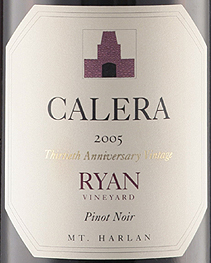

Calera Wine Company
2005 Pinot Noir, Ryan Vineyard(Mount Harlan)
This Pinot Noir from the Ryan Vineyard – the youngest of Calera’s Mt. Harlan vineyards – is already showing wonderful depth. Planted in 1998 and 2001 on Calera’s limestone soils, this is a Pinot perfectly in balance and made for the long haul (as are mostly all of Calera’s wines.
It’s very dark in color with surprisingly sweet oak, baking spices and floral notes in the nose. But the wood is barely detectable on the palate where the dusky, complex and mineral layers supersede it. It has a big, substantial texture for long-term aging for up to 15 years or so. For now, hold onto it for a couple of years to allow it to settle in. A potentially great Pinot Noir.
Only the fourth Ryan to be released, the vineyard is already showing maturity. As a measure of its balance, the pH – an indicator of acidity – is a reasoned 3.58, while the stated alcohol, at 14.2 percent, is in check. Only 18 percent of new François Freres Burgundian barrels were utilized for 16 months and the wine was bottled unfiltered. Only a little more than 1,400 cases were produced. (note: tasted from 375ml bottles)
Reviewed June 12, 2008 by Alan Goldfarb.
Other reviewed wines from Calera Wine Company
The Wine
Winery: Calera Wine Company |
The Reviewer Alan Goldfarb
Alan Goldfarb
Alan Goldfarb has been writing about and reviewing wine for 17 years. His reviews have been published in the St. Helena Star, San Jose Mercury, San Francisco Examiner, Decanter, and Wine Enthusiast, among others. Not once has he used a point system, star system, or an iconic symbol to quantify a wine. What counts in Mr. Goldfarb’s criteria when judging a wine is: how it tastes in the glass; is it well-constructed; its food compatibility; and presence of redeeming regional attributes. |


















